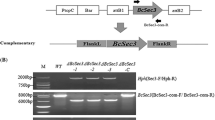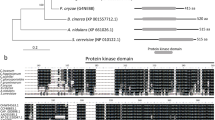Abstract
Apple Glomerella leaf spot (GLS) is a severe foliar disease of apples trees, prevalent in several countries including China, Brazil, and United States. Colletotrichum fructicola is a predominant pathogen responsible for global GLS outbreaks. C. fructicola infects apple leaves through penetration pegs that are generated from melanized appressoria, and the melanization process is crucial for their proper functioning. Scytalone dehydratase is a key enzyme in melanin biosynthesis. The role of melanin in the biology and pathogenicity of C. fructicola is poorly understood up to nowadays. In the present study, we successfully identified the gene CfSCD1 encoding scytalone dehydratase in C. fructicola isolate 030206. The expression level of CfSCD1 in germinated conidia exhibited a remarkable increase to approximately tenfold at 6 hpi, followed by a decrease to around five-fold at 12 hpi, and then stabilized from 12 to 24 hpi. The appressoria exhibited a complete morphology at 6 hpi, followed by deep melanization at 12 hpi and subsequent production of primary hyphae from the appressoria at 24 hpi. A CfSCD1 deletion mutant was generated to further elucidate gene function, revealing a significant reduction in melanin content in the ΔCfSCD1 strain. The growth of ΔCfSCD1 mycelium was inhibited by UV irradiation, and no regular appressorium formatted from the germinated conidia of ΔCfSCD1. In addition, the germinated conidia hyphae of ΔCfSCD1 exhibited a loss in their ability to invade apple leaves. CfSCD1 was identified as a crucial gene associated with conidial invasion, and its expression level may serve as an indicator of C. fructicola isolate pathogenicity.







Similar content being viewed by others
Data availability
The data and materials of the current study can be obtained from the corresponding author upon reasonable request.
References
Allam N, El-Zaher E (2012) Protective role of Aspergillus fumigatus melanin against ultraviolet (UV) irradiation and Bjerkandera adusta melanin as a candidate vaccine against systemic candidiasis. African Journal of Biotechnology 11:6566–6577
Araujo L, Gonçalves A, Stadnik M (2014) Ulvan effect on conidial germination and appressoria formation of Colletotrichum gloeosporioides. Phytoparasitica 42:631–640
Bell AA, Wheeler M (2003) Biosynthesis and functions of fungal melanins. Annual Review of Phytopathology 24:411–451
Bruno KS, Tenjo F, Li L, Hamer JE, Xu JR (2004) Cellular localization and role of kinase activity of PMK1 in Magnaporthe grisea. Eukaryotic Cell 3:1525–1532
Chen Y, Fu D, Wang W, Gleason ML, Zhang R, Liang X et al (2022) Diversity of Colletotrichum species causing apple bitter rot and Glomerella leaf spot in China. Journal of Fungi 8:740
Eisenman HC, Greer EM, McGrail CW (2020) The role of melanins in melanotic fungi for pathogenesis and environmental survival. Applied Microbiology and Biotechnology 104:4247–4257
Gonçalves A, Stadnik M (2012) Interference of ulvan on apressoria development and melanization of Colletotrichum gloeosporioides. Tropical Plant Pathology 37:431–437
Gonçalves AE, Velho AC, Stadnik MJ (2016) Formation of conidial anastomosis tubes and melanization of appressoria are antagonistic processes in Colletotrichum spp. from apple. European Journal of Plant Pathology 146:497–506
González E, Sutton TB (2004) Population diversity within isolates of Colletotrichum spp. causing Glomerella leaf spot and bitter rot of apples in three orchards in North Carolina. Plant Disease 88:1335–1340
González E, Sutton TB, Correll JC (2006) Clarification of the etiology of Glomerella leaf spot and bitter rot of apple caused by Colletotrichum spp. based on morphology and genetic, molecular, and pathogenicity tests. Phytopathology 96:982–992
Ishikawa FH, Souza EA, Shoji J-y, Connolly L, Freitag M, Read ND et al (2012) Heterokaryon Incompatibility Is Suppressed Following Conidial Anastomosis Tube Fusion in a Fungal Plant Pathogen. PLoS ONE 7:e31175
Jaswal R, Kiran K, Rajarammohan S, Dubey H, Singh PK, Sharma Y et al (2020) Effector biology of biotrophic plant fungal pathogens: Current advances and future prospects. Microbiological Research 241:126567
Jiang BW, Cai T, Yang XY, Dai Y, Yu KX, Zhang PP et al (2022) Comparative transcriptome analysis reveals significant differences in gene expression between pathogens of apple Glomerella leaf spot and apple bitter rot. BMC Genomics 23:246
Kihara J, Moriwaki A, Ito M, Arase S, Honda Y (2004) Expression of THR1, a 1,3,8-trihydroxynaphthalene reductase gene involved in melanin biosynthesis in the phytopathogenic fungus Bipolaris oryzae, is enhanced by near-ultraviolet radiation. Pigment Cell Research 17:15–23
Kubicek CP, Starr TL, Glass NL (2014) Plant cell wall-degrading enzymes and their secretion in plant-pathogenic fungi. Annual Review of Phytopathology 52:427–451
Kubo Y, Takano Y (2013) Dynamics of infection-related morphogenesis and pathogenesis in Colletotrichum orbiculare. Journal of General Plant Pathology 79:233–242
Kubo Y, Takano Y, Endo N, Yasuda N, Tajima S, Furusawa I (1996) Cloning and structural analysis of the melanin biosynthesis gene SCD1 encoding scytalone dehydratase in Colletotrichum lagenarium. Applied and Environmental Microbiology 62:4340–4344
Liang Y, Xiong W, Steinkellner S, Feng J (2018) Deficiency of the melanin biosynthesis genes SCD1 and THR1 affects sclerotial development and vegetative growth, but not pathogenicity, in Sclerotinia sclerotiorum. Molecular Plant Pathology 19:1444–1453
Liu ZT, Lian S, Li BH, Dong XL, Wang CX, Cho WK et al (2020) Development of simple sequence repeat markers based on whole-genome sequencing to reveal the genetic diversity of Glomerella cingulata in China. Journal of General Plant Pathology 86:2–12
Mendgen K, Deising H (1993) Infection structures of fungal plant pathogens - a cytological and physiological evaluation. The New Phytologist 124:193–213
Moreira RR, Bergamin Filho A, Zeviani WM, May De Mio LL (2020) Comparative epidemiology of three Colletotrichum species complex causing Glomerella leaf spot on apple. European Journal of Plant Pathology 158:473–484
Moreira RR, Peres NA, May De Mio LL (2019) Colletotrichum acutatum and C. gloeosporioides species complexes associated with apple in Brazil. Plant Disease 103:268–275
Moreira RR, Zielinski EC, Castellar C, Bergamin Filho A, May De Mio LL (2021) Study of infection process of five species of Colletotrichum comparing symptoms of Glomerella leaf spot and bitter rot in two apple cultivars. European Journal of Plant Pathology 159:37–53
O’Connell RJ, Thon MR, Hacquard S, Amyotte SG, Kleemann J, Torres MF et al (2012) Lifestyle transitions in plant pathogenic Colletotrichum fungi deciphered by genome and transcriptome analyses. Nature Genetics 44:1060–1065
Perfect SE, Hughes HB, O’Connell RJ, Green JR (1999) Colletotrichum: A model genus for studies on pathology and fungal-plant interactions. Fungal Genetics and Biology 27:186–198
Perpetua NS, Kubo Y, Yasuda N, Takano Y, Furusawa I (1996) Cloning and characterization of a melanin biosynthetic THR1 reductase gene essential for appressorial penetration of Colletotrichum lagenarium. Molecular Plant-Microbe Interactions 9:323–329
Rockenbach MF, Velho AC, Gonçalves AE, Mondino PE, Alaniz SM, Stadnik MJ (2016) Genetic structure of Colletotrichum fructicola associated to apple bitter rot and Glomerella leaf spot in Southern Brazil and Uruguay. Phytopathology 106:774–781
Shin JH, Han JH, Park HH, Fu T, Kim KS (2019) Optimization of polyethylene glycol-mediated transformation of the pepper anthracnose pathogen Colletotrichum scovillei to develop an applied genomics approach. The Plant Pathology Journal 35:575–584
Sutton TB, Sanhueza RM (1998) Necrotic leaf blotch of Golden Delicious-Glomerella leaf spot: a resolution of common names. Plant Disease 82:267–268
Takahara H, Endl E, O’Connell R (2011) Isolation of fungal infection structures from plant tissue by flow cytometry for cell-specific transcriptome analysis. Methods in Molecular Biology 729:3–13
Takano Y, Kubo Y, Shimizu K, Mise K, Okuno T, Furusawa I (1995) Structural analysis of PKS1, a polyketide synthase gene involved in melanin biosynthesis in Colletotrichum lagenarium. Molecular & General Genetics 249:162–167
Taylor J (1971) A necrotic leaf blotch and fruit rot of apple caused by a strain of Glomerella cingulata. Phytopathology 61:e224
Tsuji G, Kenmochi Y, Takano Y, Sweigard J, Farrall L, Furusawa I et al (2000) Novel fungal transcriptional activators, Cmr1p of Colletotrichum lagenarium and pig1p of Magnaporthe grisea, contain Cys2His2 zinc finger and Zn(II)2Cys6 binuclear cluster DNA-binding motifs and regulate transcription of melanin biosynthesis genes in a developmentally specific manner. Molecular Microbiology 38:940–954
Tsuji G, Sugahara T, Fujii I, Mori Y, Ebizuka Y, Shiraishi T et al (2003) Evidence for involvement of two naphthol reductases in the first reduction step of melanin biosynthesis pathway of Colletotrichum lagenarium. Mycological Research 107:854–860
Velho AC, Mondino P, Stadnik MJ (2018) Extracellular enzymes of Colletotrichum fructicola isolates associated to apple bitter rot and Glomerella leaf spot. Mycology 9:145–154
Velho AC, Stadnik MJ, Casanova L, Mondino P, Alaniz S (2014) First report of Colletotrichum karstii causing Glomerella leaf spot on apple in Santa Catarina State, Brazil. Plant Disease 98:157
Velho AC, Stadnik MJ, Wallhead M (2019) Unraveling Colletotrichum species associated with Glomerella leaf spot of apple. Tropical Plant Pathology 44:197–204
Wang B, Li BH, Dong XL, Wang CX, Zhang ZF (2015a) Effects of temperature, wetness duration, and moisture on the conidial germination, infection, and disease incubation period of Glomerella cingulata. Plant Disease 99:249–256
Wang CX, Zhang ZF, Li BH, Wang HY, Dong XL (2012) First report of Glomerella leaf spot of apple caused by Glomerella cingulata in China. Plant Disease 96:912
Wang W, Fu D-D, Zhang R, Sun G-Y (2015b) Etiology of apple leaf spot caused by Colletotrichum spp. Mycosystema 34:13–25
Wang X, Lu D, Tian C (2021a) CgEnd3 regulates endocytosis, appressorium formation, and virulence in the poplar anthracnose fungus Colletotrichum gloeosporioides. International Journal of Molecular Sciences 22:4029
Wang XL, Lu DX, Tian CM (2021b) Analysis of melanin biosynthesis in the plant pathogenic fungus Colletotrichum gloeosporioides. Fungal Biology 125:679–692
Wawrzak Z, Sandalova T, Steffens JJ, Basarab GS, Lundqvist T, Lindqvist Y et al (1999) High-resolution structures of scytalone dehydratase-inhibitor complexes crystallized at physiological pH. Proteins 35:425–439
Yu J-H, Hamari Z, Han K-H, Seo J-A, Reyes-Domínguez Y, Scazzocchio C (2004) Double-joint PCR: a PCR-based molecular tool for gene manipulations in filamentous fungi. Fungal Genetics and Biology 41:973–981
Zhang Z, Yan M, Li W, Guo Y, Liang X (2021) First report of Colletotrichum aenigma causing apple Glomerella leaf spot on the Granny Smith cultivar in China. Plant Disease 105:1563
Zhou X, Li G, Xu JR (2011) Efficient approaches for generating GFP fusion and epitope-tagging constructs in filamentous fungi. Methods in Molecular Biology 722:199–212
Acknowledgements
We would like to thank Prof. Zhonghua Ma from Zhejiang University for providing the pYF11-RFP vector.
Funding
This research was supported in part by the Natural Science Foundation of Shandong Province (ZR2020MC114); the Talents of High-Level Scientific Research Foundation of Qingdao Agricultural University (6631116026); the National Key Research and Development Program (2021YFE0104200); and the China Agriculture Research System (CARS-27).
Author information
Authors and Affiliations
Contributions
Conception and design: SL, BL.; Acquisition of data, analysis, and interpretation: ZZ, BJ, XY, YY; Drafting and revision of the manuscript: NL, WR, PL SL, BL; The authors read and approved the final manuscript.
Corresponding author
Ethics declarations
Conflict of interest
The authors declare no competing interests.
Additional information
Publisher's note
Springer Nature remains neutral with regard to jurisdictional claims in published maps and institutional affiliations.
Rights and permissions
Springer Nature or its licensor (e.g. a society or other partner) holds exclusive rights to this article under a publishing agreement with the author(s) or other rightsholder(s); author self-archiving of the accepted manuscript version of this article is solely governed by the terms of such publishing agreement and applicable law.
About this article
Cite this article
Zhang, Z., Jiang, B., Yang, X. et al. Deficiency of the melanin biosynthesis genes CfSCD1 impedes appressoria formation and disrupts Colletotrichum fructicola infection on apple. Trop. plant pathol. 48, 581–593 (2023). https://doi.org/10.1007/s40858-023-00600-w
Received:
Accepted:
Published:
Issue Date:
DOI: https://doi.org/10.1007/s40858-023-00600-w




